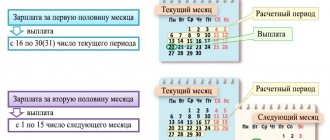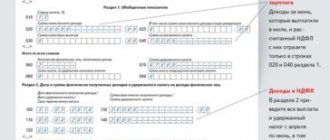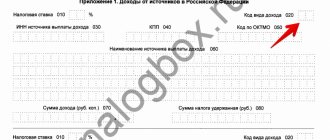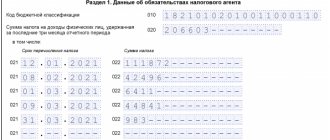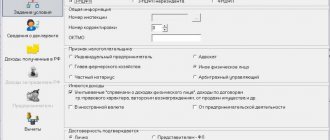Basic rules for filling out line 100 in 6-NDFL
The procedure that must be followed when filling out form 6-NDFL was approved by order of the Federal Tax Service of Russia dated October 14, 2015 No. ММВ-7-11 / [email protected] It requires that the date of actual payment of income be reflected on line 100, dividing the data on it into the required number of lines with number 100 depending on the deadline for paying the tax on this income (clause 4.2 of Appendix 2 to Order No. ММВ-7-11/ [email protected] ).
This means that the same income payment date can be distributed over several lines:
- due to the payments of this income being made in parts, which leads to different deadlines for tax payments;
- the existence of different tax payment deadlines for different types of income paid on the same date.
The date of income actually received in 6-NDFL must be determined according to the rules of Art. 223 of the Tax Code of the Russian Federation (letter of the Federal Tax Service of Russia dated November 13, 2015 No. BS-4-11/19829), which allocates the following days for these purposes:
- actual cash payment (subclause 1, clause 1), but its own rules are established for the date of receipt of income for wages (clause 2);
- payment of income in another way (subclause 2, 4 clause 1);
- receiving it in the form of special charges that do not entail the actual payment of income (subclauses 3, 5, 6, 7, clause 1).
Line 100 is included in section 2 of form 6-NDFL and, like all lines in this section (letter of the Federal Tax Service of Russia dated February 18, 2016 No. BS-3-11/650), is filled in with information related to payments in the last quarter of the reporting period. In this case, information relating to the corresponding quarter is entered into section 1 on an accrual basis and solely by the date of accrual.
Read about the procedure for filling out line 100 of form 6-NDFL here.
Reflection in reporting
Field 020 of section 1 takes into account all remuneration received by individuals, taking into account income in kind. In section 2, line 130 fills in the amount at which the received product or service is valued, field 140 shows the tax withheld from this amount.
Declaration 6 personal income tax: filling out line 060 in the report
The date of receipt of income (field 100) is considered the day of transfer of property or provision of services to an individual. For example, the date of debiting funds to pay for a trip or the day of presenting a gift to an employee.
Filling out field 110, as a rule, raises the most questions when issuing “non-cash” income. Upon receipt of goods or provision of services, personal income tax cannot be withheld on the same day, because in fact, no funds are transferred, and there is nothing to collect taxes from. Therefore, personal income tax will be withheld from the first monetary rewards that the organization pays to an individual after he receives income in kind. For example, an employee received the following types of income in June:
Is it necessary to show interest paid on a personal loan? person in 6 personal income tax
- June 5 – anniversary gift;
- June 8 – wages for May;
- June 23 – advance payment.
The employer will withhold personal income tax from the cost of the gift from the next cash payment, in this case, wages for June. Line 110 reflects the actual date of deduction of the fee - June 8. The amount of personal income tax that must be withheld cannot exceed 50% of the remuneration paid.
Important! Gifts whose value is less than 4 thousand rubles are not subject to fees and may not be reflected in the report. If the gift is more expensive, the fee is charged only on the amount that exceeds the established amount. The tax-free limit is shown in field 030.
The fee is paid to the budget immediately or the next day. But regardless of the date of the actual transfer of money, field 120 always shows the date following the day of personal income tax withholding, since this is the last date when it can be transferred. According to the rules for filling out the report, field 120 indicates exactly the deadline for payment allowed by law.
Date of actual receipt of income in 6 personal income tax
Reflection of income date for salary
The date of income received in the form of salary, the Tax Code of the Russian Federation (clause 2 of Article 223) requires that the date of its accrual be considered (i.e., the last day of the month for which it is accrued, or the last day of work, if we are talking about calculation upon dismissal) . At the same time, salaries, as a rule, are paid later than the date on which they are calculated, and the obligation to withhold and pay tax on such income is tied to the date of actual payment (clauses 4 and 6 of Article 226 of the Tax Code of the Russian Federation). At the same time, there is a ban on paying tax at the expense of the employer (clause 9 of Article 226 of the Tax Code of the Russian Federation).
Thus, according to the set of rules established by the Tax Code of the Russian Federation in relation to wages, the date of receipt of such income should be considered the day it was accrued, and in section 1 of form 6-NDFL it will be reflected on this date. But this income will fall into section 2 only during the period when the grounds for paying tax on it arise.
In this case, on line 100, the date of receipt of income will indicate the date of salary accrual corresponding to the last day of the month for which it was calculated (letter of the Federal Tax Service of Russia dated 02.12.2016 No. BS-3-11 / [email protected] , dated 02.25.2016 No. BS-4-11/ [email protected] , dated 03/15/2016 No. BS-4-11/ [email protected] , dated 04/27/2016 No. BS-4-11/7663), regardless of what this day may refer to to the previous quarter or turn out to be a holiday (letter of the Federal Tax Service of Russia dated May 16, 2016 No. BS-3-11 / [email protected] ).
The following situations require special explanation:
- Salaries are paid twice a month (advance and final payment). Payment of an advance does not entail payment of tax in connection with it. In section 2 of form 6-NDFL, the tax will be reflected only when making payments based on the results of the final calculation of wages (letter of the Federal Tax Service of Russia dated March 24, 2016 No. BS-4-11/4999).
For more information on entering data on advances into the 6-NDFL report, read the article “How to correctly reflect an advance in the 6-NDFL form (nuances)?” .
- The salary was issued ahead of schedule (before the date of its accrual). In this situation, the Federal Tax Service of the Russian Federation first proposed to reflect the data in section 2 of form 6-NDFL according to the general rules: the moment of tax withholding and the deadline for its payment will have an earlier date than the date of accrual of income (letter of the Federal Tax Service of Russia dated March 24, 2016 No. BS-4- 11/5106). However, the very next month the tax authorities’ point of view changed. Now they believe that before the end of the month, income in the form of wages cannot be considered received and personal income tax cannot be calculated and withheld before the end of the month (letter of the Federal Tax Service of Russia dated April 29, 2016 No. BS-4-11/7893). If the salary is issued ahead of schedule, personal income tax can be calculated from it only on the last day of the month, and this tax can be withheld when paying money to employees either on the last day of the month or in the next month. Accordingly, the withheld personal income tax must be transferred to the budget no later than the day following the day the income is paid to employees.
For example, if the salary of all employees is 300,000 rubles. for March was paid on 03/29/20XX, and the salary for the first half of April was paid on 04/12/20XX, then in section. 2 calculations of 6-personal income tax for the first half of the year should be shown as follows:
Line 100: 03/31/20XX.
Line 110: 04/12/20XX.
Line 120: 04/15/20XX.
Line 130: 300,000.
Line 140: 39,000.
- A similar approach to reflecting income in section 2 of the 6-NDFL report is also applied when issuing wages in the last days of December before the end of the year. The salary for December, issued on December 29, 20XX, will be reflected in section 2 of the 6-NDFL report for the 1st quarter of 20XX. This is due to the fact that the operation in section 2 of the 6 personal income tax report is reflected in the period in which the tax payment deadline occurs (letter of the Federal Tax Service of the Russian Federation dated 02.21.2017 No. BS-4-11 / [ email protected] (question No. 3), dated 01.11.2017 No. GD-4-11/ [email protected] ). In the last quarter of the reporting period, there is no payment of wages even if there are accruals in it. In section 1 of form 6-NDFL, accruals must be shown, but section 2 on payments will remain blank (letter of the Federal Tax Service of Russia dated May 24, 2016 No. BS-4-11/9194).
See also “When to pay personal income tax if the salary for December 2019 is issued in December?”
EXAMPLE of filling out line 100 of form 6-NDFL from ConsultantPlus: In the 1st quarter of 2021, the following income was accrued: - salary for January, February and March. Salaries for the first half of the month were paid respectively on 01/20/2020, 02/20/2020, 03/20/2020, and for the second - on 02/05/2020, 03/05/2020, 04/03/2020; — sick leave benefit, which was paid on 02/04/2020. In Sect. 2 6-NDFL for the 1st quarter of 2021, lines 100 are filled out as follows: For the full example, see K+.
Correctly determine the income payment period for the 6-NDFL report
In the summer of 2021, tax authorities issued many new letters explaining and clarifying how to fill out the 6-NDFL report. Despite the fact that this was the third report this year, there are no fewer questions about filling it out.
This calculation has been included in the quarterly reporting schedule this year. We also have an annual 6-personal income tax ahead, which will be surrendered along with 2-personal income tax. Regardless of the organizational form of the enterprise (LLC or individual entrepreneur) in accordance with clause 2 of Art. 230 Tax Code of the Russian Federation 6-NDFL is passed by everyone. The main condition is the availability of payments to taxpayers - individuals (remember that when calculating personal income tax, taxpayers are individuals, and an organization or individual entrepreneur is only a tax agent who withholds this tax at the place of payment of income and transfers it to the budget):
- under employment contracts (salary, bonus, etc.);
- under civil contracts (rent with an individual, contract work);
- dividends.
Only those organizations whose number does not exceed 25 individual taxpayers have the right to report on paper. The rest - only in electronic form.
According to para. 4 and 5 paragraphs 2 art. 230 of the Tax Code of the Russian Federation, if there are separate divisions, the organization’s accountant must:
- take into account personal income tax for employees by department;
- transfer personal income tax to the tax office (IFTS) where this unit is registered with the corresponding checkpoint of the unit and OKTMO of this tax office;
- submit 6-NDFL reports for each division to the relevant Federal Tax Service with the corresponding checkpoint of the division.
The accountant of an individual entrepreneur located on the UTII system or the patent system (hereinafter referred to as the patent) transfers personal income tax and reports on personal income tax in accordance with paragraph. 6 paragraph 2 art. 230 of the Tax Code of the Russian Federation to the tax office at the place of activity of this individual entrepreneur. If an individual entrepreneur is on the simplified tax system, then he transfers personal income tax and reports on it to the tax office at his place of residence.
POSITION OF THE FTS
If an individual entrepreneur combines two types of activities, one of which is on UTII and the other on the simplified tax system, in this case the accountant, like the accountant of the organization, will have to make both payments and reports to all tax inspectorates where he is registered, while not forgetting to indicate the correct OKTMO.
— Letter dated 08/01/2016 No. BS-4-11/ [email protected]
Section 1 of the personal income tax report contains “Generalized indicators”, and if the enterprise pays income taxed at different personal income tax rates (there are residents and non-residents, for example), then lines 010–050 are filled in for each personal income tax rate (13, 15, 30 or 35%).
The applied personal income tax rate is indicated on line 010 of this section.
Line 020 indicates the amount of income subject to this personal income tax rate.
On line 030 we summarize tax deductions:
- standard;
- property;
- social;
- professional.
As well as amounts of non-taxable income (for example, material assistance or gifts up to 4,000 rubles, financial assistance at the birth of a child up to 50,000 rubles) according to Art. 217 Tax Code of the Russian Federation.
Payments that are completely exempt from personal income tax, such as: maternity benefits, child care benefits, severance pay within three times the monthly salary, are not reflected in the 6-personal income tax report. Daily allowances for business trips are reflected only when the limits are exceeded, i.e. over 700 rubles. throughout the country and over 2500 rubles. - beyond.
On line 040 we indicate the amount of calculated tax (line 020 - line 030 x line 010).
Lines 025 (income in the form of dividends), 045 (personal income tax on the amount of dividends) and 050 (the amount of a fixed advance payment for foreign workers on a patent) are filled in in cases where these indicators are available.
Regardless of whether one personal income tax rate or several is indicated, lines 060–090 are filled in once.
Line 060 is the number of taxpayers who received income from this enterprise.
If an employee quits in a given tax period and is then rehired, then according to clause 3.3 of the Procedure for filling out the calculation by order of the Federal Tax Service dated October 14, 2015 No. ММВ-7-11/ [email protected] on page 060, he is reflected as one person .
GOOD TO KNOW
If, when transferring personal income tax, an error was made in the checkpoint or OKTMO, then the accountant will need to write a letter to the tax office to clarify the payment. But if an error in the checkpoint and OKTMO was made when submitting the report, then the procedure for its actions is prescribed in the letter of the Federal Tax Service of Russia dated August 12, 2016 No. GD-4-11/14772 “On the submission of an updated calculation in form 6-NDFL”.
Example 1.
For 6 months, 8 people were indicated in the 6-NDFL report, in July 3 people left the enterprise, in September 5 people were hired, including one person who returned to this enterprise. Based on the results of 9 months, 10 people should be reflected on page 060, that is, 8 people as of 01.07 - (3 dismissed - 1 returned) + (5 hired - 1 returned).
If a taxpayer has several types of income taxed at different rates, then he is taken into account on page 060 as one person.
Line 070 reflects the amount of tax withheld, that is, there should be the amount of tax withheld according to the dates from Section 2.
line 080 in the case when the tax agent does not have the opportunity to withhold personal income tax from the income of an individual, for example, upon dismissal of this person or if this taxpayer was given income not in monetary terms, but, for example, in the form of a valuable gift.
If the taxpayer was returned the amount of previously withheld personal income tax in accordance with Art. 231 of the Tax Code of the Russian Federation, then this amount must be reflected on line 090.
Section 1 must be completed cumulatively from the beginning of the year, but Section 2 must be completed only for the reporting quarter.
Moreover, if the salary payment for September 2021 is made in October 2021, then in Section 1 this salary must be reflected on line 020 - in the amount of accruals, on line 030 - the amount of deductions from this salary and on line 040 - in the amount of calculated personal income tax. But it will be withheld on the day the salary is paid, so neither in Section 1 (p. 070) nor in Section 2 for the third quarter is it necessary to reflect the amount of personal income tax from the September salary. These amounts will be included in the report at the end of the year.
IMPORTANT IN WORK
6-NDFL must be sent by tax agents recognized as such in accordance with Art. 226 and 226.1 of the Tax Code. If there are no employees on the staff of an organization (individual entrepreneur) and during the year they were not accrued and, accordingly, were not paid income, then such an organization is not a tax agent. Consequently, there is no obligation to submit a 6-NDFL calculation to the tax authority.
When other cash payments and income in kind are recognized
For other payments made in money or in any other way, the date of receipt of income will be considered the day on which the corresponding event occurred (clause 1 of Article 223 of the Tax Code of the Russian Federation):
- payment of money (subparagraph 1);
- issuance of income in kind (subclause 2);
- offset of mutual claims (subclause 4).
That is, for the purposes of reflection in section 2 of form 6-NDFL, the date of receipt of income will coincide with the day of payment for such income as:
- vacation pay (letters of the Federal Tax Service of Russia dated May 11, 2016 No. BS-3-11/ [email protected] , dated May 11, 2016 No. BS-4-11/8312), while justified recalculations of vacation pay in section 1 of form 6-NDFL are taken into account in the period recalculation (letter of the Federal Tax Service of Russia dated May 24, 2016 No. BS-4-11/9248);
- sick leave (letter of the Federal Tax Service of Russia dated February 25, 2016 No. BS-4-11/ [email protected] );
- financial assistance (letter of the Federal Tax Service of Russia dated May 16, 2016 No. BS-4-11/ [email protected] );
- one-time bonuses (letters of the Federal Tax Service of Russia dated October 6, 2017 No. GD-4-11/20217, dated June 8, 2016 No. BS-4-11/ [email protected] , Ministry of Finance of Russia dated September 29, 2017 No. 03-04-07/63400, dated September 29, 2017 No. 03-04-07/63400);
For more information about the features of the moment of recognition of income received in the form of a bonus, read the article “ How to correctly reflect a one-time bonus in 6-NDFL.”
- dividends;
For information on how dividends are reflected in the 6-NDFL form, read the article “How to correctly reflect dividends in the 6-NDFL form?”
- income issued in kind (letter of the Federal Tax Service of Russia dated March 28, 2016 No. BS-4-11/ [email protected] ).
For information about the specifics of filling out a report if it is impossible to withhold tax for payments in kind, read the article “Example of filling out 6-NDFL with sick leave .
For details on filling out the 6-NDFL form, see the material “Checklist for filling out 6-NDFL for the 2nd quarter of 2020.”
Date for financial benefits, savings on interest and travel allowances
Special dates are established for the recognition of income received, the actual payment of which does not occur, but they are subject to tax (clause 1 of Article 223 of the Tax Code of the Russian Federation):
- for financial benefits from the acquisition of goods, works, services (subclause 3) - the date of receipt of such income, and if we are talking about the purchase of securities paid for after the transfer of ownership of them, then the day of their payment;
- income from writing off bad debts of an interdependent individual from the balance sheet of an organization (subclause 5 of Article 223 of the Tax Code of the Russian Federation, letter of the Federal Tax Service of Russia dated 02/08/2018 No. GD-4-11 / [email protected] ) - the date of such write-off, in a situation where when it is impossible to withhold tax, section 2 of form 6-NDFL is not filled out for them (letters from the Federal Tax Service of Russia dated November 24, 2015 No. BS-4-11/ [email protected] , dated March 18, 2016 No. BS-4-11/ [email protected] );
- excess travel expenses (subclause 6) - the last date of the month in which the advance report was approved;
- financial benefits from saving on interest when receiving a loan (sub-clause 7) - the last day of each month during the period of use of such funds.
Article 223. Date of actual receipt of income
1. Applying the rules of paragraph 1 of Art. 223, you need to take into account that:
- they have the nature of general rules, i.e. subject to application, unless otherwise provided in paragraph 2 of Art. 223 (see below for more information);
- in accordance with them, the date of actual receipt of income is defined as a day (remember that an action for which a deadline has been established can be performed before 24 hours of the last day of the period. If documents or amounts of money were submitted by post or telegraph before 24 hours of the last day of the deadline, then the deadline is not considered missed, Article 6.1 of the Tax Code):
1) payment of income when receiving income in cash (including when receiving income in foreign currency):
- from the cash register of an organization (being an employer), as well as from the cash register of other organizations, from individual entrepreneurs (including from employers), other individuals (for example, from private notaries, etc.);
- by transfer to the taxpayer’s bank accounts or to third party bank accounts (as directed by the taxpayer).
In the practice of legal clients, a number of questions arose: does subclause 1 of clause 1 of Art. 223 also accounts of taxpayers (for example, individual entrepreneurs) opened in accordance with the established procedure not in a bank, but in another credit organization? Do the rules subclause apply? 1 clause 1 art. 223 for cases of transfer by mail of money to the taxpayer?
Answering the first question, it should be taken into account that in accordance with Art. 11 of the Tax Code, the word “bank” in the norms of the Tax Code refers to both banks themselves and other credit organizations licensed by the Central Bank of the Russian Federation. In this regard, the day of transfer of income amounts to his account opened with a non-bank credit organization is also the date of actual receipt of income by the individual.
When answering the second question, it should be borne in mind that in the rules of subclause 1, clause 1, art. 223 there is a gap. It is also clear that transferring money by mail is a cash (and not in kind) form of payment of income. It is clear, however, that transferring money by mail (say, to an individual's home address) is not a transfer to the taxpayer's bank account. Nevertheless, it follows from the literal text of subparagraph 1, paragraph 1, art. 223. It is impossible to apply them (and equate the transfer of money by mail to a transfer to a bank account) to cases of transfer of money by mail: the fact is that the Tax Code (being an act of public law) does not provide for the possibility of applying either an analogy of law or an analogy of law (as , for example, this is allowed by the rules of Article 6 of the Civil Code, but we should not forget that, firstly, this is the sphere of private law, and secondly, it applies to property relations based on administrative or other power subordination of one party to the other, incl. Part of tax relations, civil legislation does not apply, unless otherwise expressly provided for by law, Article 2 of the Civil Code). In connection with the above, the legislator needs to fill this gap, and tax authorities and taxpayers need to remember that when determining the date of actual receipt of income (by transferring money by mail), one must proceed from the fundamental provisions of Art. 3, 108 (that all irremovable doubts, contradictions, ambiguities in acts of legislation on taxes and fees are interpreted in favor of the taxpayer).
A number of other questions have arisen in practice: what day is considered the day of payment of money when transferring it to the taxpayer’s bank account: the day this money is credited to the taxpayer’s account? The day the payment order is submitted to the bank (for transferring) money to the taxpayer; day of debiting money from the bank account of the organization - the source of payment? And what rules should be followed in this case: Art. 45 NK or Art. 316 Civil Code?
When answering these interrelated questions, you need to keep in mind that relations for transferring money from one bank account to another bank account are regulated by the norms of the Civil Code (Articles 845 - 866 of the Civil Code) and banking rules issued in accordance with them (see more about this in book: Guev A.N. Article-by-article commentary to part 2 of the Civil Code of the Russian Federation (ed. 2). pp. 465 - 489). As for the provisions of Art. 45 of the Tax Code (stating that the obligation to pay tax is considered fulfilled by the taxpayer from the moment the bank presents an order to pay the corresponding tax if there is a sufficient cash balance in the taxpayer’s account), then they relate specifically to cases of payment of tax amounts to the relevant budget (and before January 1, 2001 - and to extra-budgetary funds). In this regard, it is necessary to proceed from the provisions of Art. 316 of the Civil Code that a monetary obligation (to pay income to an individual) is considered fulfilled at the place of residence of the individual. This means that the date of actual receipt of income is determined based on the day the money is credited to the taxpayer’s bank account;
2) transfer of income in kind - when the taxpayer receives income in kind (see the commentary on this to Article 211 of the Tax Code). In this case, the day of actual receipt of income is defined as the day of actual fulfillment of the obligation to transfer income:
a) in a place determined by law (for example, Article 97 of the Labor Code establishes that wages are paid, as a rule, at the place where workers perform work), by contract (for example, the parties to a contract stipulate that remuneration is given to the contractor at the place where work is performed in in kind), business customs;
b) in the place (if neither the law, nor the contract, nor the custom of business practice allows us to determine the place of fulfillment of the obligation):
— delivery of property to the taxpayer (or the first carrier for delivery to the taxpayer), if payments are made in the form of transfer of goods or other property that involves its transportation;
- production or storage of property, if it was known to the taxpayer at the time the employer’s obligation to transfer goods or other property (which does not involve its transportation) arose;
- location of real estate - if the payment to the taxpayer is made in the form of transferring rights to real estate to him (Article 316 of the Civil Code);
3) payment to the taxpayer of interest on borrowed (credit) funds received, if the income is received in the form of material benefits (we are talking about income received in the form of an excess of the amount of interest for the use of borrowed funds, expressed in rubles or in foreign currency, over the amount of interest calculated based on the terms of the contract, see the detailed commentary on this to paragraph 2 of Article 212 of the Tax Code).
If the material benefit was expressed in receiving:
a) benefits from the acquisition of goods (work, services) from an individual in accordance with a civil contract or from an organization and individual entrepreneur that are interdependent in relation to the taxpayer (Article 20 of the Tax Code, subparagraph 2 of paragraph 1 of Article 212 of the Tax Code) , then the date of actual receipt of income is determined as the day of purchase of these goods (works, services). In this case, the benefit consists in the excess of the price of identical (homogeneous) goods (works, services) sold (by persons who are interdependent in relation to the taxpayer), under normal conditions to persons who are not interdependent, over the sales price of identical (homogeneous) goods (works, services) to the taxpayer (see the detailed commentary on this to paragraph 3 of Article 212 of the Tax Code);
b) benefits from the acquisition of securities (it is defined as the excess of the market value of securities over the amount of actual expenses of the taxpayer for their acquisition, see the detailed commentary on this to paragraph 4 of Article 212 of the Tax Code), then the date of actual receipt of income is determined as the day of acquisition (in accordance with the applicable Securities Law) securities (for example, shares, bonds, etc.).
2. Specifics of the rules of paragraph 2 of Art. 223 is that:
a) they relate only to determining the date of receipt by the taxpayer of one type of income, namely the amount of wages. Let's remember that she:
- paid only to persons who have an employment relationship with the employer (i.e., on the basis of an employment agreement (contract), Articles 15 - 24 of the Labor Code);
- should, as a general rule, be paid at least every half month (Article 96 of the Labor Code);
- should, as a rule, be paid at the place of performance of work (Article 97 of the Labor Code);
- can have both monetary and in-kind form (Article 83 of the Labor Code);
- must be paid in compliance with other provisions of Chapter VI of the Labor Code (see more about this in the book: Guev A.N. Article-by-article commentary of the Labor Code of the Russian Federation (ed. 4). M., 2001);
b) they do not apply to cases of payment of remuneration to individuals under civil contracts (for example, under work contracts, paid services, copyright agreements, etc.);
c) in accordance with them, the date of actual receipt of income in the form of salary (another form of remuneration) is considered to be the last day of the month for which the salary was accrued. It does not matter in this case that the amount of remuneration (already accrued):
- paid already in the next month (which most often happens: for example, salaries for March are usually paid in April, etc.);
— paid earlier on the last day of the month mentioned. So, in the employer organization, the salary payment day is the 26th of the current month (i.e., the salary for October, for example, is not only accrued in October, but is also paid in October - on the 26th). However, the day of actual receipt of income is considered to be the last day of the month (in our example, October 31).
In practice, questions have arisen: how to determine the day of actual receipt of income if the last day of the month (for which the salary is accrued) coincides with a non-working day (holiday or weekend)? Are the rules of Art. 6.1 Tax Code (that in cases where the last day of the period falls on a non-working day, the day of expiration of the period is considered to be the next working day)?
Let us first answer the last question: the rules of Art. 6.1 Tax codes are not applicable in this case. Further: if the last day of a given month (for which the salary is accrued) falls on a non-working day, one should proceed from the imperative requirements of paragraph 2 of Art. 223 that the day of actual receipt of income is considered to be the last day of the month (it does not matter that it is a non-working day).
How is the amount of income actually received shown?
The amount of income actually received on the date indicated in line 100 is given in line 130 as a single amount, if there are no grounds for dividing income into different sheets (due to different tax rates) or lines (due to the need to separate according to the timing of tax payment) report. Its value is the value before tax is withheld from it, i.e. it includes the amount of tax accrued on this income (clause 4.2 of Appendix 2 to Order No. ММВ-7-11 / [email protected] ).
If the same date of actual receipt is present for income taxed at the same rate, but having different tax payment deadlines, then these incomes are entered into Form 6-NDFL in different lines with number 100 (letter of the Federal Tax Service of Russia dated May 11, 2016 No. BS-4-11 /8312).
Results
Entering the date of actual receipt of income in Form 6-NDFL has its own characteristics depending on the type of income. In terms of salary payments, there are additional nuances related to the chronology of accruals and payments.
Sources:
- Tax Code of the Russian Federation
- Order of the Federal Tax Service of Russia dated October 14, 2015 No. ММВ-7-11/ [email protected]
You can find more complete information on the topic in ConsultantPlus. Free trial access to the system for 2 days.

